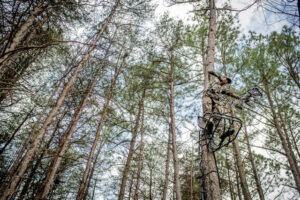 If bowhunting big deer is not a game of inches, then surely it is one of feet. You can do some awesome scouting and find a killer spot ripped with buck sign. But if you move in with a stand and set it a foot too low…or angled on the south side of a tree as a 10-pointer marches in from the west… You get it. If your positioning is off just a bit, you might as well be off a mile, because you are probably not going to shoot that buck.
If bowhunting big deer is not a game of inches, then surely it is one of feet. You can do some awesome scouting and find a killer spot ripped with buck sign. But if you move in with a stand and set it a foot too low…or angled on the south side of a tree as a 10-pointer marches in from the west… You get it. If your positioning is off just a bit, you might as well be off a mile, because you are probably not going to shoot that buck.
Use this guide to fine-tune your stand placement for better shots.
Size matters. A straight tree 15-20 inches in diameter is perfect for any type stand, “lock-on,” ladder or climber. It is easy and safe to get your arms around a tree in that size range as you set steps, climb and hang. Once you’re up and hunting, a tree just as wide as your body breaks your outline, but it’s narrow enough so that you can turn and look, and lean right or left and draw and shoot without the tree binding you up.
Once you’ve chosen a tree, back up 50 to 60 yards, bend and look up into the top of it from a deer’s perspective to see which height and angle provide the best backdrop for a stand. Some limbs to the front and sides are good, but a solid back-screen (i.e a big fork or mess of vines) that breaks your outline is better.
As a rule, hang stands 17 to 20 feet high. That’s high enough to stay above the eyes and noses of deer, but low enough so you’ll feel safe and solid standing and drawing. Plus, 18 feet is the ideal height from which to view a deer’s vitals from the side, and then drill the lungs with a double-lung shot. If you’re a sky-walker go higher if you want, but be careful! I still don’t think you need to.
Face your stand to cover the 180 degrees of woods out front where you expect to see a buck. You want to spot him early and get ready. Then, if you shoot right-handed, angle the perch on the tree so that the prevailing wind hits the left side of your body (vice versa for southpaws). That positions you to stand, draw and shoot with minimal movement when a buck shows up out front. The wind won’t blow perfectly prevailing every day, but unless it’s dead wrong, angling your stand this way will work on most hunts.
For morning hunts, face stands to the northwest to south, and point evening stands to the northeast to south. That hides you well in shadows, and deer that look into the rising or setting sun behind you won’t bust you. Plus, you have the best visibility, and enough light to shoot right up until legal time begins or ends.
If you use ladder sections with a lock-one, always run those steps a foot or tow higher than where you’ll hang the stand. For example, if your stand is 18 feet, run steps up to 19. Climb to the very top, and then step easily and safely down onto the platform. No more lunging or pulling up or squirreling into a stand!
Position and lock the platform/seat level as level as you can or tipped slightly up. If the configuration of a tree is such that the foot platform leans down even a few inches (or if you hang it sloping down) that is no good. It’s uncomfortable, and you won’t feel stable when you stand up to shoot.
A straight tree is best, but one that leans slightly back and toward your downwind side will work well. Hang your stand on the “up” front side of the tree, and it will be set perfectly for comfort and shooting, with the wind in your face.
Once your stand is set, rope up your bow, sit and look all around; stand, extend your bow and move it through an arc to cover every angle where you might shoot. Saw any limb or twig that might grab a bow limb, knock an arrow off the rest or otherwise mess you up.
Trim at least three shooting lanes in the treetops and on the ground out to 50 yards on the upwind side of your stand. Don’t do a pulpwood job and cut too much, but make sure you can shoot a buck in three spots. Drag cut limbs and saplings downwind and behind the tree so they can’t block or turn a buck that approaches one of your shooting lanes.





